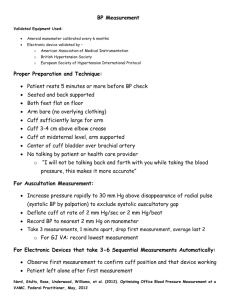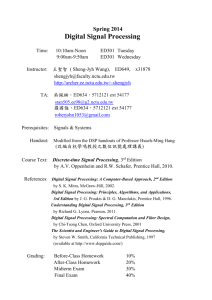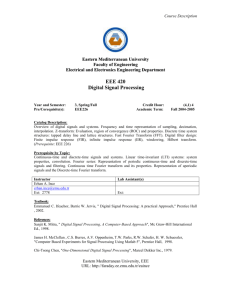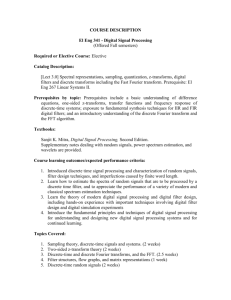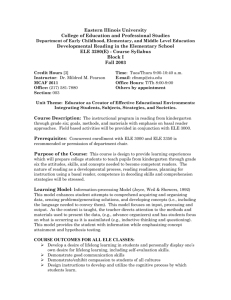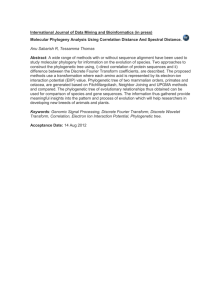Lecture 9 ELE 301: Signals and Systems Discrete-time Fourier Transform
advertisement
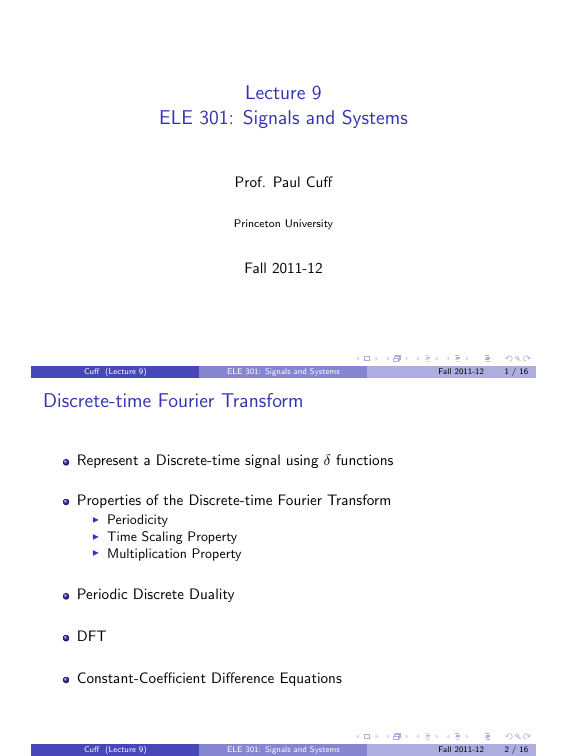
Lecture 9 ELE 301: Signals and Systems Prof. Paul Cuff Princeton University Fall 2011-12 Cuff (Lecture 9) ELE 301: Signals and Systems Fall 2011-12 1 / 16 Fall 2011-12 2 / 16 Discrete-time Fourier Transform Represent a Discrete-time signal using δ functions Properties of the Discrete-time Fourier Transform I I I Periodicity Time Scaling Property Multiplication Property Periodic Discrete Duality DFT Constant-Coefficient Difference Equations Cuff (Lecture 9) ELE 301: Signals and Systems Fourier Transform for Discrete-time Signals Z x[n] = X (f )e i2πfn df , 1 ∞ X X (f ) = x[n]e −i2πfn . n=−∞ X (f ) is always periodic with period 1. Cuff (Lecture 9) ELE 301: Signals and Systems Fall 2011-12 3 / 16 Continuous-representation of a discrete-time signal ∞ X x(t) , x[k]δ(t − k). k=−∞ Notice that ∞ ∞ X −∞ k=−∞ Z F[x(t)] = = = ∞ Z X ∞ ! x[k]δ(t − k) e −i2πft dt x[k]δ(t − k)e −i2πft dt k=−∞ −∞ ∞ X x[k]e −i2πfk dt. k=−∞ Cuff (Lecture 9) ELE 301: Signals and Systems Fall 2011-12 4 / 16 Properties of the Discrete-time Fourier Transform Inherits properties from continuous-time. Easy Properties: Linearity Conjugation Convolution = Multiplication in frequency domain Parseval’s Theorem (integrate over one period) Time shift Properties that require care: Time-scaling Multiplication (circular convolution in frequency) Cuff (Lecture 9) ELE 301: Signals and Systems Fall 2011-12 5 / 16 Time-scaling In continuous time we can scale by an arbitrary real number. In discrete-time we scale only by integers. For an integer k, define x[n/k] if n is a multiple of k, xk [n] = 0 if n is not a multiple of k. xk [n] ⇔ X (kf ). Cuff (Lecture 9) ELE 301: Signals and Systems Fall 2011-12 6 / 16 Compressing in time Compressing in time requires decimation. Cuff (Lecture 9) ELE 301: Signals and Systems Fall 2011-12 7 / 16 Fall 2011-12 8 / 16 Discrete Difference What is the Fourier transform of y [n] = x[n] − x[n − 1]? Cuff (Lecture 9) ELE 301: Signals and Systems Dual Derivative Formula The dual to the continuous-time differentiation formula still holds. nx[n] ⇔ Cuff (Lecture 9) i 0 X (f ). 2π ELE 301: Signals and Systems Fall 2011-12 9 / 16 Accumulation What is the Fourier transform of y [n] = Pn m=−∞ x[m]? (Hint: Inverse of discrete difference) Cuff (Lecture 9) ELE 301: Signals and Systems Fall 2011-12 10 / 16 Parseval’s Theorem Theorem: Ex = ∞ X |x[n]|2 = n=−∞ Cuff (Lecture 9) Z 1/2 |X (f )|2 df . −1/2 ELE 301: Signals and Systems Fall 2011-12 11 / 16 Multiplication Property Multiplication in time equates to circular convolution in frequency. Notice that multiplying δ functions is not well defined. This is dual to what we saw in the Fourier series. Cuff (Lecture 9) ELE 301: Signals and Systems Fall 2011-12 12 / 16 Discrete Periodic Duality periodic signal = discrete transform (though not integer f ) discrete signal = periodic transform Cuff (Lecture 9) ELE 301: Signals and Systems Fall 2011-12 13 / 16 Discrete Fourier Transform Notice that a discrete and periodic signal will have a discrete and periodic transform. This is convenient for numerical computation (computers and digital systems). The DFT is (almost) equivalent to the discrete-time Fourier series of the periodic extension. For period N, let x = x[0] x[1] .. . x[N − 1] Then DFT [x] = a0 a1 .. . aN−1 9) Fourier series ELE coefficients. 301: Signals and Systems where Cuff a (Lecture are the Fall 2011-12 14 / 16 The DFT Matrix Since the Fourier transform is linear, the DFT can be encompassed in a matrix. DFT [x] = Fx. Matlab uses the fast-Fourier-transform algorithm to compute the DFT (using the fft command). Cuff (Lecture 9) ELE 301: Signals and Systems Fall 2011-12 15 / 16 Constant-Coefficient Difference Equations n X k=0 ak y [n − k] = M X bk x[n − k]. k=0 Find the Fourier Transform of the impulse response (the transfer function of the system, H(f )) in the frequency domain. Cuff (Lecture 9) ELE 301: Signals and Systems Fall 2011-12 16 / 16

